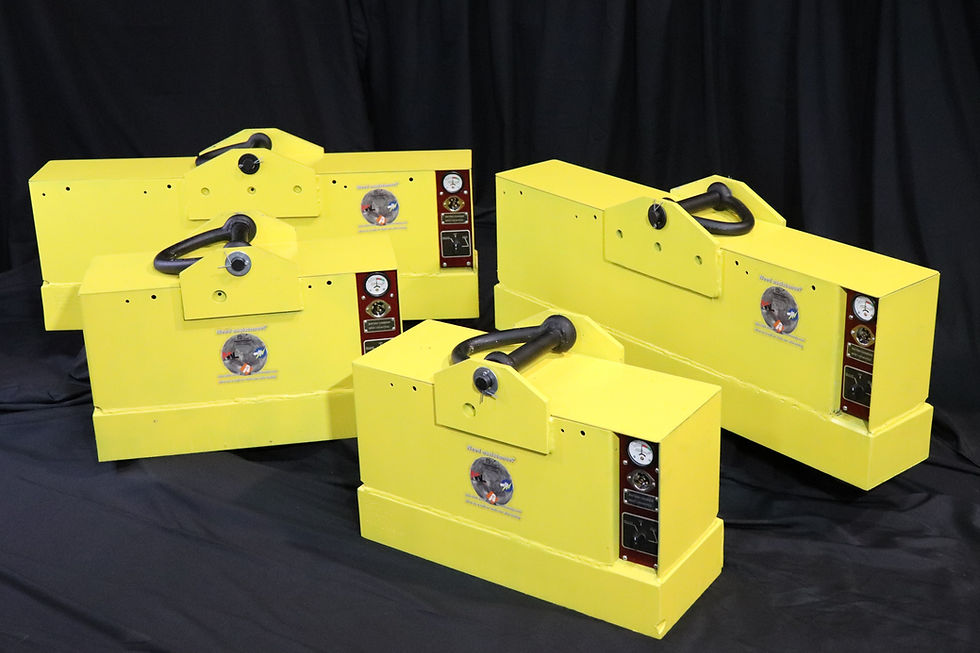National Safety Month: MagnaLift & Power-Grip Lift Magnets
- Ben Nordman

- Jun 14, 2021
- 4 min read
Updated: Aug 13
Following up on our last #ObsidianMFG surface grinding blog to go along with National Safety Month, it’s only appropriate to bring you some lift magnet considerations when it comes to safety.
Lifting material is essential to companies as it is the only way many can even move their material. Serving a wide range of industries, MagnaLift and Power-Grip lift magnets have provided a steady, uncomplicated supply of lift magnets for decades, providing an undeniably large impact on the development of the infrastructure of the United States as well as globally.

Just like with all machine tools, lift magnets also degrade with continual heavy usage. As lift magnets wear, the likelihood of a failure to properly lift increases due to multiple dynamics. These dynamics fall under three different categories: load characteristics, preventative maintenance, and natural conditions.
While this might be a cheat sheet to lift magnet safety, these are not the only considerations when moving your material. Specific conditions and materials always make lifting safety different from company to company.
Load characteristics
While the magnet might do the most work, the load characteristics are just as important for safe lifting. First, making sure that both the load and the magnet have clean, flat lifting surfaces is important. Magnetism relies on a solid connection between the magnet and the load with no air in between the two. Cracks, rust, chips, and burrs all make the connection spotty between the magnet and the load surface. Light deburring can assist in making the surfaces flat, but deeper and heavier gouges might require grinding.
Other load characteristics, such as weight, length, width, and thickness, all make an impact. Obviously, ensure the material's weight does not exceed the magnet's rated lifting capacity, which depends on the model.

Beyond the weight, thickness is another aspect to consider. Magnetism requires iron to actually attract, meaning the more iron present, the better the connection there will be. In terms of thickness, the thicker the piece, the more iron there is, and the better the connection will be.
With length and width, droopiness is the issue when a piece is too long or too wide and not thick enough. Remembering that any air between the magnet and the piece causes air to be trapped between and weaken the connection strength, when a piece of material sags on the ends or sides, that can allow air to get between the lifting surface.
The actual material that is being lifted is also crucial for safety. With each alloy containing differing amounts of iron, the strength of the connection can differ between two different materials. Keep this in mind as you are lifting different materials.
Preventative maintenance
Preventing anything from happening will always come before dealing with the aftermath of an incident. There’s no difference with lift magnets. Keeping the components of the lift magnet current is the main key to preventative maintenance.
A majority of the magnets designed and built under the MagnaLift and Power-Grip lines are operated by a regular car battery. With each battery, maintaining a solid charge is important to magnetize a lift magnet to full strength. A battery that is low on power will cause the magnet to lose some of its power. An overnight charge will give the battery and magnet the ability to lift all day.

The panel meter indicates the battery's charge level. For a fully charged battery, the meter pointer will be ¼ into the safe green area on the magnet side, indicating 12 volts. The green/red boundary represents 10.8 battery volts. Further dropping of voltage (into the RED zone) reduces the magnet lifting capacity to an unsafe condition. If in the red zone, the magnet should not be used to lift.
Along with battery maintenance, annual testing and certification will avoid any failures of other components within the magnet. Sending your magnet to us to test and then certify helps ease the pain of knowing how much life a magnet has left. If a magnet fails our extensive testing, we recommend the next steps, whether it be a rebuild or the potential for a new magnet.
Natural Conditions
Of course, not everything is always in the operator’s control. Natural conditions, such as the temperature in which the magnet is operated, affect the lifting ability of the magnet. Car batteries can be affected by temperature changes. Think of how difficult it is to start a car in the middle of winter. Applying that to lift magnets, operators need to be wary of how the magnet is stored and sudden temperature changes with their lift magnets.

Like a lot of machine tools, lift magnets have safety protocols that need to be met in order to keep an operator safe. While not everything above applies in all situations, these general guidelines can be followed to keep everyone safe. Always be sure to follow the official guidelines put forth by OSHA in your shop. Look HERE for more information about lift magnet safety, and check out artergrinder.com later this week for Arter Precision Grinding Machine safety!
MagnaLift & Power-Grip Lift Magnets

Obsidian Manufacturing Industries, Inc. is a Rockford, Ill., manufacturing company and is the OEM for Magna-Lock USA workholding, MagnaLift & Power-Grip lift magnets, and Arter Precision Grinding Machines, as well as providing surface grinding services. They are located at 5015 28th Ave. in Rockford, Ill., with a phone number of 815-962-8700. Check out more at obsidianmfg.com/brands.
.png)



Comments